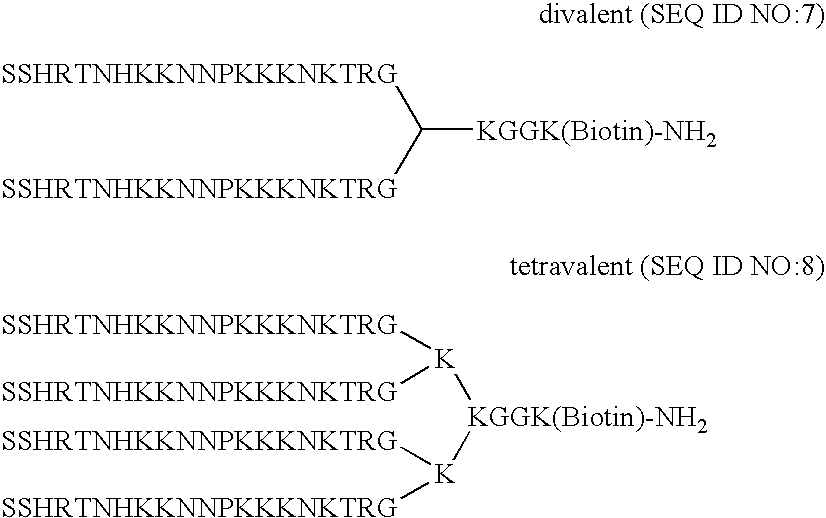Compositions and methods for promoting attachment of cells of endothelial cell lineage to medical devices
a technology of endothelial cells and cell lines, which is applied in the field of compositions and methods for promoting the attachment of cells of endothelial cell lines to an intravascular device, can solve the problems of unacceptably high thrombosis rates limited arterial bypass procedures, and the association of small caliber grafts with these devices, so as to promote the endothelialization of the vascular device, promote the spread of cells
- Summary
- Abstract
- Description
- Claims
- Application Information
AI Technical Summary
Benefits of technology
Problems solved by technology
Method used
Image
Examples
example 1
[0046] Illustrated in this example are various methods for producing a surface-binding domain and a endothelial-binding domain for the biofunctional coating compositions according to the present invention. Many of the peptides comprising the binding domains in the biofunctional coating composition according to the present invention (i.e., a surface-binding domain and an endothelial-binding domain) were developed using phage display technology.
[0047] Phage display technology is well-known in the art, and can be used to identify additional peptides for use as binding domains in the interfacial binding materials according to the present invention. In general, using phage display, a library of diverse peptides can be presented to a target substrate, and peptides that specifically bind to the substrate can be selected for use as binding domains. Multiple serial rounds of selection, called “panning,” may be used. As is known in the art, any one of a variety of libraries and panning metho...
example 2
[0050] This example illustrates the discovery and characterization of surface-binding domains comprising peptides having binding specificity for a metallic surface of a medical device, such as a stainless steel surface of a stent.
A. Phage Screening and Selections.
[0051] As a specific illustrative example, nonspecific binding sites in wells containing stainless steel stent material in polystyrene microtiter plates were blocked with a buffer containing 1% bovine serum albumin for 2 hours at room temperature. The wells and stainless steel stent material were then washed three times with PBS-T. The plate was incubated for 1 hour at room temperature with shaking at 50 rpm. Each of 17 different phage display libraries was diluted in PBS+1% BSA and was added at a concentration of 1010 pfu / ml in a total volume of 250 μl. After a 1 hour incubation at room temperature with shaking at 50 rpm, 70 μl of bovine serum was added, and then the plates were incubated at 37° C. with shaking for 1 ho...
example 3
[0061] This example illustrates the discovery and characterization of endothelial-binding domains comprising peptides having binding specificity for cells of endothelial cell lineage.
A. Phage Screening and Selections.
[0062] Phage libraries were pooled into four groups and screened for peptides that bind to human umbilical vein endothelial cells (HUVECs). The four pools were first pre-cleared on non-target cells (e.g., cells other than cells of endothelial cell lineage). For each pool, 10 μL of phage (1010 of phage) was added to 1×106 cells of each of the following cell types: HEK-293 cells, aortic vascular smooth muscle cells (AoSMC), and platelets. The phage and cells were incubated for 1 hour at room temperature. Cells and attached phage were pelleted by centrifugation. The phage remaining in the supernatant were used for subsequent selections on HUVECs. Selections on HUVECS were performed using methods known in the art, including by one or more of biopanning with the cells inc...
PUM
| Property | Measurement | Unit |
|---|---|---|
| diameter | aaaaa | aaaaa |
| molecular weight | aaaaa | aaaaa |
| molecular weight | aaaaa | aaaaa |
Abstract
Description
Claims
Application Information
 Login to View More
Login to View More - R&D
- Intellectual Property
- Life Sciences
- Materials
- Tech Scout
- Unparalleled Data Quality
- Higher Quality Content
- 60% Fewer Hallucinations
Browse by: Latest US Patents, China's latest patents, Technical Efficacy Thesaurus, Application Domain, Technology Topic, Popular Technical Reports.
© 2025 PatSnap. All rights reserved.Legal|Privacy policy|Modern Slavery Act Transparency Statement|Sitemap|About US| Contact US: help@patsnap.com

